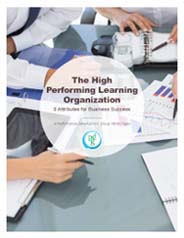If you were born around 1980 or after, we all kind of owe you an apology. Because we dubbed you a “Millennial” and we talk about you like you are some kind of other species. You see it everywhere: What do Millennials want? How do Millennials think? And, yes, inevitably, how do Millennials learn?
Let me clear the air here: Millennials are just people. Can we stop talking about them like they’re not?
Do Millennials learn differently from everybody else? I don’t think so. But there is something that’s different about them: their expectation as to how they will receive learning is different than the generations that came before.
Millennials are Digital Natives. They were born into a world where computers were everywhere, the internet always existed, and phones were little hand-held computers that went everywhere with us. Virtually all of them used computers in their primary and secondary education, and many used iPads. Having information at their fingertips is not revolutionary for them; it’s the way the world has always worked. Being part of a crowd-sourced knowledge community is not new to them; having access to informal and social learning is common; getting advice or mentoring from someone far away is not unusual. For many from this generation, learning is not an event; it’s something they do all the time, and it’s become second nature.
So you can imagine what happens when they come into a corporate environment and content is taught in lectures or didactic e-learning. In a world where they are able to learn virtually anything at any time, when information is mere seconds away, where a robust learning community is there for the asking—why would you limit your methods? It’s the moral equivalent of going to work at a company that transports their goods in horse carts—why would you do that when there are much better methods commonly available?
But here’s the catch: Millennials don’t learn differently. They just expect to learn differently. Lecture and didactic learning have always been very limited ways to learn. But in the pre-internet age, most people didn’t expect to learn differently, because the methods didn’t exist yet. So all those great learning methods that we attribute to Millennials are great for Gen X, Baby Boomers, and, frankly, all other humans.
So thanks to the Millennials for helping us learn how to learn. And let’s use those great techniques to help everybody be more effective.

Rich Mesch is Vice President, Customer Engagement at Performance Development Group. A frequent contributor to industry events and publications, his most recent article was Taming the Learning Demand Curve: Using Supply Chain Methods to Manage Your Learning Function for Training Industry's online magazine.


 PDG recently published a new white paper called
PDG recently published a new white paper called 
 Challenge 1: How does this relate to me? Can you recall a time when you were totally uninterested and unmotivated to learn? Maybe in grade school during history class? For me it was college math. I simply was not interested. Why? I did not ever think calculus was something I would use in “real life.”We know from adult learning principles that people learn best when they can see the relevance the content has to their day-to-day jobs, and to their lives. So, one would think the answer is simple: show people how the content is relevant to them, and they will be open to learning it. As important as this concept is, it’s something designers forget to do as they get all caught up in designing the learning.
Challenge 1: How does this relate to me? Can you recall a time when you were totally uninterested and unmotivated to learn? Maybe in grade school during history class? For me it was college math. I simply was not interested. Why? I did not ever think calculus was something I would use in “real life.”We know from adult learning principles that people learn best when they can see the relevance the content has to their day-to-day jobs, and to their lives. So, one would think the answer is simple: show people how the content is relevant to them, and they will be open to learning it. As important as this concept is, it’s something designers forget to do as they get all caught up in designing the learning.  We have all heard of corporate agility. We hear the term “agile” all the time related to today’s corporate environment: agile processes, agile practices, agile leadership. In our rapidly changing world, agility is one of the most important skills an organization can have if it is to stay competitive. Agility is the ability to move quickly, change rapidly, and respond to crises, threats and opportunities at the point of need. Of course, the ability to be agile relies on the ability of the organization to quickly gain the knowledge they need to do so. Rapid access to knowledge and information drives the learning agile organization, as defined by Clark and Gottfredson in
We have all heard of corporate agility. We hear the term “agile” all the time related to today’s corporate environment: agile processes, agile practices, agile leadership. In our rapidly changing world, agility is one of the most important skills an organization can have if it is to stay competitive. Agility is the ability to move quickly, change rapidly, and respond to crises, threats and opportunities at the point of need. Of course, the ability to be agile relies on the ability of the organization to quickly gain the knowledge they need to do so. Rapid access to knowledge and information drives the learning agile organization, as defined by Clark and Gottfredson in 



